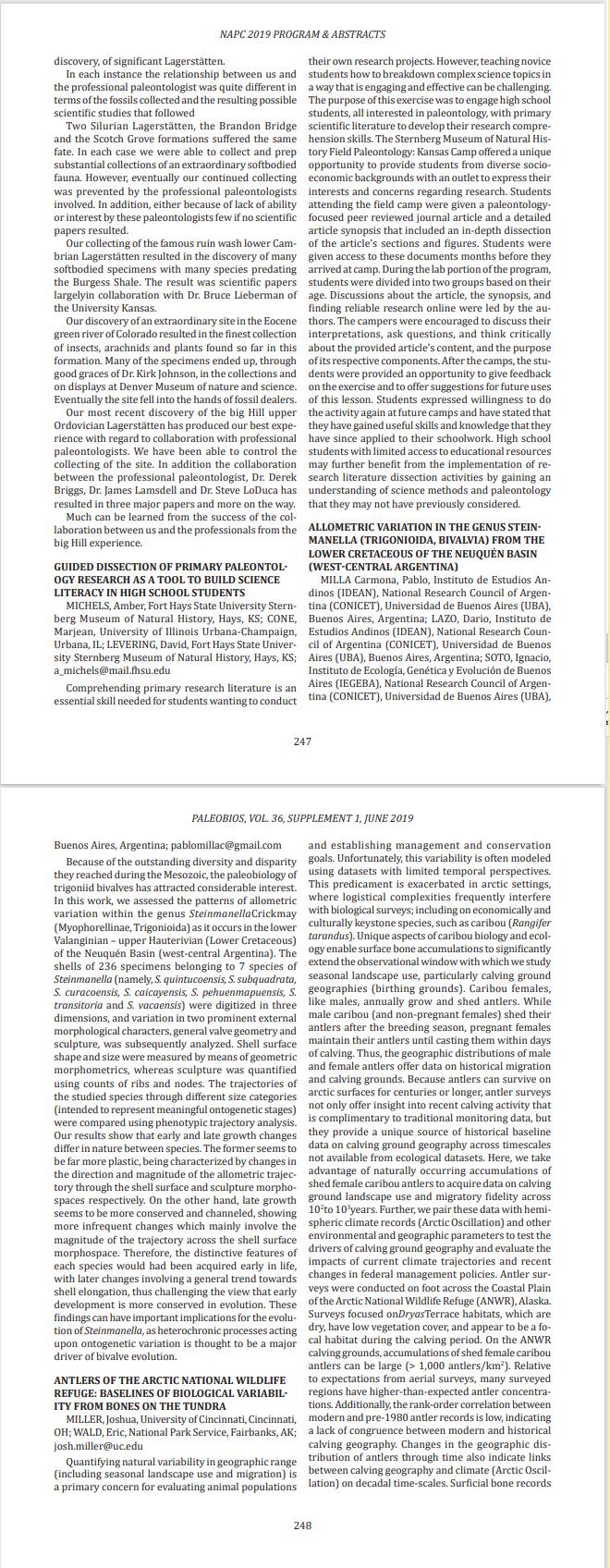Mostrar el registro sencillo del ítem
dc.contributor.author
Milla Carmona, Pablo Sebastián

dc.contributor.author
Lazo, Dario Gustavo

dc.contributor.author
Soto, Ignacio Maria

dc.date.available
2022-06-09T04:09:23Z
dc.date.issued
2019
dc.identifier.citation
Allometric variation in the genus Steinmanella (Trigonioida, Bivalvia) from the Lower Cretaceous of the Neuquén Basin (west-central Argentina); 11th North American Paleontological Convention; Riverside; Estados Unidos; 2019; 247-248
dc.identifier.issn
0031-0298
dc.identifier.uri
http://hdl.handle.net/11336/159306
dc.description.abstract
Because of the outstanding diversity and disparity they reached during the Mesozoic, the paleobiology of trigoniid bivalves has attracted considerable interest. In this work, we assess the patterns of allometric variation within the genus Steinmanella (Myophorellinae, Trigonioida) as it occurs in the lower Valanginian - upper Hauterivian (Lower Cretaceous) of the Neuquén Basin (west-central Argentina). A sample of 236 specimens belonging to 7 species of Steinmanella (namely, S. quintucoensis, S. subquadrata, S. curacoensis, S. caicayensis, S. pehuenmapuensis, S. transitoria and S. vacaensis), was digitized in three dimensions, and variation in two prominent external morphological characters, general geometry and sculpture, was subsequently analyzed. Shell surface shape and size were measured by means of 3D geometric morphometrics, whereas sculpture was quantified using counts of ribs and nodes. The trajectories of the studied species through different size categories (intended to represent meaningful ontogenetic stages) were compared using phenotypic trajectory analysis. Our results show that early and late growth changes differ in style across species. The former seems to be far more plastic, being characterized by changes in the direction and magnitude of the allometric trajectory in the shell surface and sculpture morphospaces, respectively. On the other hand, late growth seems to be more conserved and channelled, showing more infrequent changes which mainly involve the magnitude of the trajectory across the surface morphospace. Therefore, the distinctive features of each species would had been acquired early in life, with later changes involving a general trend towards elongation of the shell, thus challenging the view that early development is more conserved in evolution. These findings can have important implications for the evolution of Steinmanella, as heterochronic processes acting upon ontogenetic variation is thought to be a major driver of bivalve evolution.
dc.format
application/pdf
dc.language.iso
eng
dc.publisher
University of California Museum of Paleontology
dc.rights
info:eu-repo/semantics/openAccess
dc.rights.uri
https://creativecommons.org/licenses/by-nc-sa/2.5/ar/
dc.subject
Steinmanella
dc.subject
Allometric variation
dc.subject
Geometric morphometrics
dc.subject.classification
Paleontología

dc.subject.classification
Ciencias de la Tierra y relacionadas con el Medio Ambiente

dc.subject.classification
CIENCIAS NATURALES Y EXACTAS

dc.title
Allometric variation in the genus Steinmanella (Trigonioida, Bivalvia) from the Lower Cretaceous of the Neuquén Basin (west-central Argentina)
dc.type
info:eu-repo/semantics/publishedVersion
dc.type
info:eu-repo/semantics/conferenceObject
dc.type
info:ar-repo/semantics/documento de conferencia
dc.date.updated
2022-03-17T14:03:53Z
dc.journal.pagination
247-248
dc.journal.pais
Estados Unidos

dc.journal.ciudad
Berkeley
dc.description.fil
Fil: Milla Carmona, Pablo Sebastián. Consejo Nacional de Investigaciones Científicas y Técnicas. Oficina de Coordinación Administrativa Ciudad Universitaria. Instituto de Estudios Andinos "Don Pablo Groeber". Universidad de Buenos Aires. Facultad de Ciencias Exactas y Naturales. Instituto de Estudios Andinos "Don Pablo Groeber"; Argentina
dc.description.fil
Fil: Lazo, Dario Gustavo. Consejo Nacional de Investigaciones Científicas y Técnicas. Oficina de Coordinación Administrativa Ciudad Universitaria. Instituto de Estudios Andinos "Don Pablo Groeber". Universidad de Buenos Aires. Facultad de Ciencias Exactas y Naturales. Instituto de Estudios Andinos "Don Pablo Groeber"; Argentina
dc.description.fil
Fil: Soto, Ignacio Maria. Consejo Nacional de Investigaciones Científicas y Técnicas. Oficina de Coordinación Administrativa Ciudad Universitaria. Instituto de Ecología, Genética y Evolución de Buenos Aires. Universidad de Buenos Aires. Facultad de Ciencias Exactas y Naturales. Instituto de Ecología, Genética y Evolución de Buenos Aires; Argentina
dc.relation.alternativeid
info:eu-repo/semantics/altIdentifier/url/https://escholarship.org/uc/item/6r18f8wn
dc.conicet.rol
Autor

dc.conicet.rol
Autor

dc.conicet.rol
Autor

dc.coverage
Internacional
dc.type.subtype
Congreso
dc.description.nombreEvento
11th North American Paleontological Convention
dc.date.evento
2019-06-23
dc.description.ciudadEvento
Riverside
dc.description.paisEvento
Estados Unidos

dc.type.publicacion
Journal
dc.description.institucionOrganizadora
Paleontological Society
dc.source.revista
PaleoBios
dc.date.eventoHasta
2019-06-27
dc.type
Congreso
Archivos asociados
